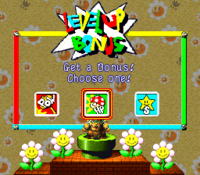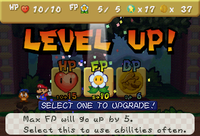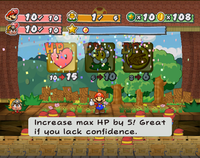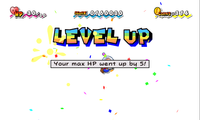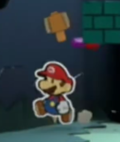Level up
It has been requested that this article be rewritten and expanded to include more information.
- This article is about the game mechanic. For the board game, see Super Mario Level Up!
- “Wahoo! One more suit, and it's 1-Up time! I mean, level-up time!”
- —Mario, Fortune Street
Level up is a term in role-playing games. Characters must defeat enough enemies in battle to gain enough experience points to level up. As characters grow to higher levels, more experience points are needed to level up. Once characters level up, their stats are increased, and in some games, they may also learn a new skill or attack.
History
Super Mario RPG: Legend of the Seven Stars
Upon leveling up in this game, Mario or one of his party members can choose one of three stat combinations to get a bonus on along with the regular stat boost. The three choices are attack and defense, represented by a hammer; max HP, represented by a Mushroom; and magic attack and magic defense, represented by a star. These bonuses are slightly boosted at certain levels: physical bonuses are higher on levels that are 3n (n being an integer), HP bonuses are higher on levels that are 3n + 1, and magic bonuses are higher on levels that are 3n - 1. At certain levels, the characters learn a new special magic ability. The maximum level is 30.
Paper Mario series
Paper Mario and Paper Mario: The Thousand-Year Door
In both of these games, Mario levels up when he collects 100 Star Points. Instead of the requirement for leveling up increasing with each level, the number of Star Points gained from enemies decreases as Mario increases in level, eventually to the point that weak enemies stop rewarding Mario with Star Points.
At each level up, Mario must choose one of his stats to boost. If he chooses HP or FP, his maximum for that stat increase by five points. If he chooses BP, his maximum BP is increased by three points. The stats not chosen remain unchanged. Unlike most RPGs, leveling up never directly increases Mario's attack power.
Leveling up also fully restores Mario's HP, FP, and SP, as well as his active partner's HP in Paper Mario: The Thousand-Year Door. The maximum level Mario can reach is 27 in Paper Mario, and 99 in The Thousand-Year Door.
In Paper Mario, the music played when the player levels up is an arrangement of the Grass Land theme from Super Mario Bros. 3.
Mario's partners can also be ranked up, similar to a level up, which increases their attack power and teaches them a new move, and increases their HP in Paper Mario: The Thousand-Year Door. In Paper Mario, this is done using a Super Block. These blocks are spread throughout the Mushroom Kingdom. Using one allows Mario to upgrade one of his party members to Super Rank. After he has received the Ultra Stone from Raphael the Raven, he can use Super Blocks to upgrade Super Rank partners to Ultra Rank. Each Super Block can be used only once.
In Paper Mario: The Thousand-Year Door, Merlon can level up Mario's partners, for three Shine Sprites each. One level up upgrades a partner to Super Rank. To level up the partners again, Mario must first obtain the Up Arrow. After doing so, Merlon can level them up to the Ultra Rank.
Super Paper Mario
In this game, the characters level up after obtaining enough points in the player's score. Level up bonuses are preset, alternating between an increase of five HP at every even-numbered level and one attack point at every odd-numbered level. All party members in this game share the same stats, excluding Bowser, who shares HP but has double attack. As is the case with The Thousand-Year Door, the maximum level the party can reach is 99. Notably, it is possible to level up twice simultaneously, unlike in the previous games.
Like in the previous two Paper Mario games, the player's HP is fully restored with each level up.
Mario's party can also permanently increase their HP and attack power without leveling up by using the HP Plus and Power Plus items. However, both of these items are very rare.
Paper Mario: Sticker Star and Paper Mario: Color Splash
In both Paper Mario: Sticker Star and Paper Mario: Color Splash, stats such as HP and attack power do not increase via enemy battles, as in previous installments. Instead, Mario gradually gets stronger as he progresses through the story, with progressively stronger Stickers or Battle Cards appearing more often as Mario collects more Royal Stickers and Big Paint Stars. However, items that permanently increase Mario's stats also exist, similarly to leveling up from previous games in the series. By collecting HP-Up Hearts, Mario's HP increases by a certain amount (5 points in Sticker Star and 25 points in Color Splash), allowing for a grand total of 100 HP in Sticker Star and 200 HP in Color Splash. Mario's First Strike attack power also increases whenever he collects two HP-Up Hearts in the former game or a Big Paint Star in the latter game.
In Paper Mario: Color Splash, defeating enemies yields Hammer Scraps, which function similarly to Star Points from the first two games in the series. By collecting a certain number of these, Mario's paint storage grows bigger, up to a maximum of 600 points.
Mario & Luigi series

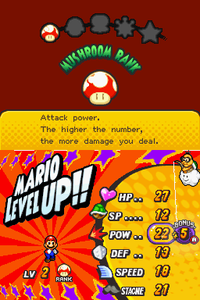
In these games, max HP, max BP (Mario & Luigi: Superstar Saga, Mario & Luigi: Dream Team, Mario & Luigi: Paper Jam, Mario & Luigi: Superstar Saga + Bowser's Minions, and Mario & Luigi: Bowser's Inside Story + Bowser Jr.'s Journey) or max SP (Mario & Luigi: Bowser's Inside Story only), Power, Defense, Speed, and Stache (Horn for Bowser) are all initially increased immediately after leveling up (though in Mario & Luigi: Partners in Time and Mario & Luigi: Dream Team, Stache never increases on its own), generally anywhere from zero to five points, but as high as fourteen in Mario & Luigi: Partners in Time. The player can then choose any stat they want and give additional points to it, though this is not possible in Mario & Luigi: Paper Jam.
A roulette (carried by a Fishin' Lakitu in the first three games in the series, or a Boo, in the case for Bowser in Mario & Luigi: Bowser's Inside Story and its remake) determines how many additional points are added. The possibilities are one to five in Mario & Luigi: Superstar Saga, Mario & Luigi: Dream Team, Mario & Luigi: Superstar Saga + Bowser's Minions, and Mario & Luigi: Bowser's Inside Story + Bowser Jr.'s Journey; one to six in Mario & Luigi: Partners in Time; and one to nine in Mario & Luigi: Bowser's Inside Story. However, the roulette often does not include this entire range, since the numbers that appear on the roulette are reduced with each level-up a given stat is upgraded and increased with each level-up that it is not upgraded.
The highest level in Mario & Luigi: Superstar Saga, Mario & Luigi: Bowser's Inside Story, Mario & Luigi: Superstar Saga + Bowser's Minions, and Mario & Luigi: Bowser's Inside Story + Bowser Jr.'s Journey is level 99, while the highest level in Mario & Luigi: Partners in Time, Mario & Luigi: Dream Team and Mario & Luigi: Paper Jam is level 100.
In Mario & Luigi: Bowser's Inside Story and its following games (excluding Mario & Luigi: Superstar Saga + Bowser's Minions), if the player reaches a certain level, they rank up, and receive special benefits.
Itadaki Street series
The level system in the Template:Wikia series, including Itadaki Street DS and Fortune Street, is different. Instead of experience points, the player must collect all four Suits scattered around the board and return to the bank to level up. By using Suit Yourself cards, these reduce the amount of Suits required for a player to level up.
In Fortune Street, it is also known as a Promotion.
When a player levels up, a fanfare plays depending on which character levels up:
- Mario character: A remix of the "Course Clear" music from New Super Mario Bros. plays.
- Dragon Quest character: A remix of the "Gained Level" music from Dragon Warrior plays.
- Mii character: Based upon which board is being played.
There is one exception: In the Practice Board, all characters use the Dragon Quest level up fanfare (even when Toad gets a promotion).
When a player levels up, they get money for their salary as follows:
| Type | Calculation |
|---|---|
| Base salary | B |
| Promotion bonus | P × L |
| Shop bonus | S ÷ 10 (rounded down) |
| Total | Sum of the three values above |
The variables for determining the player's salary is:
| Variable | Description |
|---|---|
| B | The fixed amount the player gets. |
| P | An amount that controls the amount the player gets corresponding to their level. |
| L | The player's level before promotion. |
| S | The sum of all the player's shop value. |
Should a player's Net Worth reach the target amount after the salary gets added to the player's bank upon leveling up, that player automatically wins the board.
There is also a venture card that gives the player a sudden promotion without having to return to the bank.
Puzzle & Dragons: Super Mario Bros. Edition
The player's teammates in Puzzle & Dragons: Super Mario Bros. Edition can not only level up by winning battles in courses (only for those in the player's active team, however), but can level up quicker by depowering other teammates in the player's Ally Box for their XP to other allies in the Power Up spot at Toad Houses. Depowering teammates removes them from the player's Ally Box and up to five allies can be depowered at a time. Teammates getting an ally's XP receive 50% more if their attributes match. Coin Coffers and King Coin Coffers provide a significant power up for teammates using this method.
The maximum level teammates can reach depends on the type of teammate: "low-tier" teammates that have not transformed into stronger forms have a maximum level of 25; "mid-tier" teammates that have transformed but have not transformed as far as they can, Hammer Bros, and "Bob-omb and Lakitu"s have a maximum level of 50; Leaders, Helpers, the Koopalings, Bowser Jr., Boom Boom, "top-tier" teammates that have transformed as far as they can, Lakitus, Flame Chomps, Magikoopas, and Gold Goombas have a maximum level of 99. Coin Coffers and King Coin Coffers have a maximum level of 1 and cannot level up any further. The higher the teammate's maximum level, the more XP is required to level up.
Mario & Sonic at the Rio 2016 Olympic Games
The Road to Rio mode in the 3DS version of Mario & Sonic at the Rio 2016 Olympic Games features several Training Gyms where the player can train by participating at an event of the 3DS version of Mario & Sonic at the London 2012 Olympic Games. Depending on the place reached, the player gains Training Points. After enough Training Points have been obtained, the Mii levels up and gain stars that are needed to wear outfits. The maximum level is 10.
Mario Kart Tour
In Mario Kart Tour, the player can raise their level or multiplayer rank by racing on courses and getting high placements. Characters, karts, and gliders can also be leveled up by using level-boost tickets and obtaining duplicates of them from pipes and the Shop.
Official profiles
Mario & Luigi: Dream Team
- Instruction manual description: "To defeat enemies more easily, you need to train Mario and Luigi by actively seeking battles and leveling up."
- Terms
- Game mechanics
- Mario & Luigi: Bowser's Inside Story
- Mario & Luigi: Partners in Time
- Mario & Luigi: Superstar Saga
- Mario & Luigi: Dream Team
- Mario & Luigi: Paper Jam
- Paper Mario
- Paper Mario: The Thousand-Year Door
- Super Mario RPG: Legend of the Seven Stars
- Super Paper Mario
- Fortune Street
- Puzzle & Dragons: Super Mario Bros. Edition
- Mario & Sonic at the Rio 2016 Olympic Games

